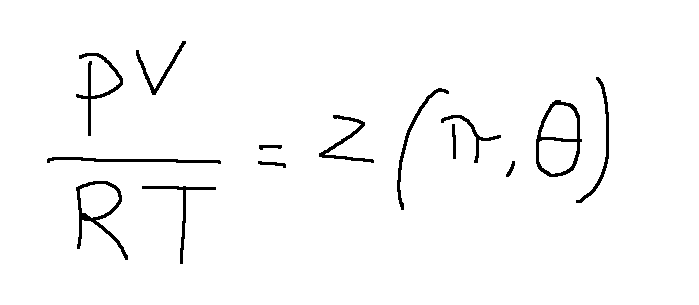28-03-2024 - Physics - Fundamentals of thermodynamics (5/13)[EN]-[IT]

~~~ La versione in italiano inizia subito dopo la versione in inglese ~~~
ENGLISH
28-03-2024 - Physics - Fundamentals of thermodynamics (5/13)[EN]-[IT]
Open thermodynamic systems
The mixture
Saturation
The saturation of a mixture represents a thermodynamic condition strictly dependent on the temperature of the system
Ideal gases and real gases
Formula
Below is the formula that characterizes generic real gases.

IN this formula we find the letter z. In this case z is called the compressibility factor, π is the reduced pressure, θ is the reduced temperature.
Specific real gases - Pitzer
In specific real gases, a new parameter must be taken into account which is identified with the letter ω.
In specific real gases ω is called the acentric Pitzer factor.
Therefore ω is precisely called the acentric Pitzer factor and takes into account the geometry and polarities of the molecule of the particular real gas under study.
open thermodynamic systems
Local equilibrium
A system is in local equilibrium when it is assimilated to a small volume consisting of a point with its interior and will instantly reach equilibrium conditions.
Eulerian view mode
The so-called Eulerian point of view mode means taking a reference space, placing yourself in certain fixed points and observing the particles (an example is measuring the temperature), as if we were taking photographs.
Lagrangian view mode
The mode called Lagrangian point of view means choosing particles, moving with them and measuring their temperature as their position varies. I took temperature as an example, but we can measure other characteristics.
mass continuity
Mass flow rate
Below is the mass flow formula

The mass flow rate is measured in Kg/sec
Volume flow rate
Below is the volumetric flow formula

The mass flow rate is measured in m3/sec
First law of thermodynamics for open systems
First law
The first law of thermodynamics for open systems states that the energy associated with a M.C. (control mass) can vary over time due to two different types of energy flows: thermal power and mechanical power.
Another more concise definition:
An open system is a thermodynamic system that can exchange both energy and matter with the outside.
Examples: The human body emitting heat into the environment, liquids in containers that are not hermetically sealed, the internal combustion engine of a car.
Conclusions
In open thermodynamic systems the energy can vary due to the energy flow generated by the thermal power and that generated by the mechanical power.
Request
Have you ever tried to carry out studies in open thermodynamic systems?

28-03-2024 - Fisica - Fondamenti di termodinamica (5/13)[EN]-[IT]
Sistemi termodinamici aperti
La miscela
Saturazione
La saturazione di una miscela rappresenta una condizione termodinamica strettamente dipendente dalla temperatura del sistema
Gas ideali e gas reali
Formula
Qui di seguito la formula che caratterizza i gas reali generici.

IN questa formula troviamo la lettera z. In questo caso z è detto fattore di comprimibilità, π è la pressione ridotta, θ è la temperatura ridotta.
Gas reali specifici - Pitzer
Nei gas reali specifici bisogna tenere conto di un nuovo parametro che viene identificato con la lettera ω.
Nei gas reali specifici ω è detto fattore acentrico di Pitzer.
Quindi ω è detto appunto fattore acentrico di Pitzer e tiene conto della geometria e delle polarità della molecola del particolare gas reale oggetto di studio.
sistemi termodinamici aperti
Equilibrio locale
Un sistema è in equilibrio locale quando viene assimilato ad un volumetto costituito da un punto con il suo interno e si porterà istantaneamente nelle condizioni di equilibrio.
modalità di vista euleriano
La modalità detta punto di vista euleriano significa prendere uno spazio di riferimento, mettersi in certi punti fissi e osservare le particelle (un esempio è misurare la temperatura), come se scattassimo delle fotografie.
modalità di vista lagrangiano
La modalità detta punto di vista lagrangiano significa scegliere delle particelle, muoversi con esse e misurare la loro temperatura al variare della loro posizione. Ho preso come esempio la temperatura, ma possiamo misurare altre caratteristiche.
continuità di massa
Portata massica
Qui di seguito la formula della portata massica

La portata massica si misura in Kg/sec
Portata volumetrica
Qui di seguito la formula della portata volumetrica

La portata massica si misura in m3/sec
Prima legge della termodinamica per i sistemi aperti
Prima legge
La prima legge della termodinamica per i sistemi aperti stabilisce che l'energia associata ad una M.C. (massa di controllo) può variare nel tempo a causa di due differenti tipi di flussi energetici: potenza termica e potenza meccanica.
Altra definizione più sintetica:
Un sistema aperto è un sistema termodinamico che può scambiare con l'esterno sia energia che materia.
Esempi: Il corpo umano che emette calore nell'ambiente, i liquidi in contenitori non ermeticamente chiusi, il motore endotermico di un'autovettura.
Conclusioni
Nei sistemi termodinamici aperti l'energia può variare a causa del flusso energetico generato dalla potenza termica e da quello generato dalla potenza meccanica.
Domanda
Avete mai provato ad effettuare studi in sistemi termodinamici aperti?
THE END
Congratulations @stefano.massari! You have completed the following achievement on the Hive blockchain And have been rewarded with New badge(s)
Your next target is to reach 64000 upvotes.
You can view your badges on your board and compare yourself to others in the Ranking
If you no longer want to receive notifications, reply to this comment with the word
STOPCheck out our last posts:
The physics thermodynamic always easy to understand just that most people does not usually understand this
Thermodynamics is not that simple for everyone, I agree. Today, however, it has become a very important science, especially for studying the thermodynamic systems that are created in a home and for studying the various heat losses.
In this article I like to underline the formula that characterizes generic real gases, that is:
Where Z is the compressibility factor, π is the reduced pressure, and θ is the reduced temperature
Physics thermodynamics is a very interesting course
It isn’t just interesting but wide too
In this article I talk about mass flow rate (1) and volumetric flow rate (2). I report them below.
They are important for understanding the mass continuity equation. Let's study this equation to better understand open thermodynamic systems.
If we talk about open systems, the first thing to learn is that the first law of thermodynamics for open systems establishes that the energy associated with a M.C. (control mass) can vary over time due to two different types of energy flows, i.e. of thermal power and mechanical power.
I forgot, when we talk about open systems the second law of thermodynamics for open systems is also important and establishes the following.
The entropy associated with a control mass can vary over time due to entropic flow and entropic production.
Non ho mai fatto
Grazie pe aver risposto. Ammetto che è insolito fare studi termodinamici di sistemi aperti se non si eseguono lavori specifici durante la propria vita. Grazie per essere passato di qua. Direi che in questo articolo un concetto importante è quello dell'equilibrio locale di un sistema termodinamico aperto.
Un sistema è in equilibrio locale quando viene assimilato ad un volumetto costituito da un punto con il suo intorno e si porterà istantaneamente nelle condizioni di equilibrio. Questo secondo me è un concetto importante quando si inizia a parlare di sistemi termodinamici aperti.